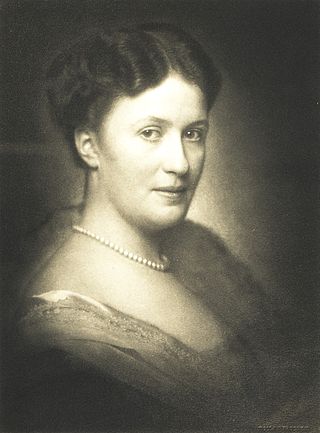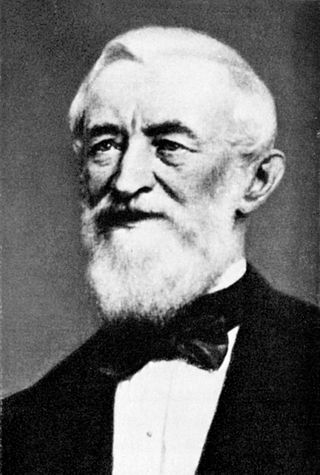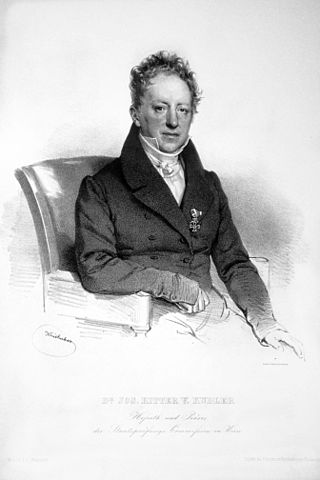
Sir Paul Eduard von Schoeller (15 June 1853 - 2 November 1920) was an Austrian mining industrialist.

Sir Paul Eduard von Schoeller (15 June 1853 - 2 November 1920) was an Austrian mining industrialist.
Schoeller was born on 15 June 1853 in Vienna. He came from the Viennese line of the Schoeller family and was the son of the merchant Johann Paul von Schoeller (1808–1882), who was born in Düren and worked in Vienna, and was ennobled in 1867, and his wife Pauline (née Schoeller) Schoeller (1812–1877). His maternal grandfather was Düren cloth manufacturer Johann Peter Schoeller, a brother of Leopold Schoeller and thus a distant cousin. [1]

After studying in Vienna, Leipzig and at the Federal Polytechnic Institute in Zurich, he and his brother, Philipp Wilhelm von Schoeller, were trained in various companies owned by his uncle Alexander von Schoeller. Soon afterwards, he was commissioned by his uncle to take over and restructure the rolled barley factory he had founded in 1853 in Ebenfurth near Vienna, the Schoeller'sche Dampfmühle, which had run into financial problems as a result of Hungarian competition. In 1894, he also bought the First Vienna Rolling Mill Vonwiller. During his time in Ebenfurth, Schoeller also played a key role in the construction of a new private railway for freight traffic from Ebenfurth to Wittmansdorf with a connection to Leobersdorf. [1]
After having worked for the wholesale company Schoeller & Co. (which later became Schoellerbank) in Vienna for a long time, Schoeller became a partner in 1883. After the death of his uncle Alexander in 1886, and the death of his cousin Gustav Adolph von Schoeller, just three years later, he and his brother Philipp Wilhelm initially became the sole heirs of the entire company empire. However, as his brother soon withdrew more and more from the operational business, Paul Eduard took over sole management of the company. [1]
In order to concentrate on just one steel company, Schoeller sold both his one-third share in the Berndorf Metal Goods Factory, and that of his deceased cousin, Gustav Adolph, in a swap deal to the third shareholder, Arthur Krupp, who thereby became sole owner. [2] In return, he received Krupp's shares in the Ternitzer Steel and Iron Works from Schoeller & Co., making that the entire company family owned. After Gustav Adolph had already begun modernisation measures at the Ternitzer plant in his final years and had also founded an independent shell factory to produce war material, Paul Eduard pushed ahead with expansion. He replaced the previous mechanical use of hydropower with a modern turbine-driven power plant and swapped the outdated Bessemer process for the new Siemens-Martin process. This enabled his steel types to establish themselves on the world market and the associated ammunition factory also became a major supplier of large-caliber grenades and other armaments for World War I. Under Paul Eduard's leadership, the family business reached its greatest economic expansion. He appointed his cousin from the Brno branch of the family, Richard von Schoeller, as manager of the main plant in Ternitz, which later, in 1924, merged with the Bleckmann steelworks to form Schoeller-Bleckmann Steelworks. [1]
Schoeller also represented the interests of the United Kingdom of Great Britain and Ireland as Consul General in Vienna from 1892 to 1912. For his services, he was made a Knight Bachelor in 1912. [3] Furthermore, in 1902, due to his political commitment to the Liberal Constitutional Party in Austria, he was appointed a lifelong member of the House of Lords of the Imperial Council of Austria. [4]
Schoeller died, without issue, on 2 November 1920 in Vienna and was buried in the Grinzing Cemetery. After his death in 1920, his cousin Richard von Schoeller became the sole heir to the family empire. Another cousin, Robert von Schoeller, succeeded him as director of the Leipnik-Lundenburg Sugar Factory. His nephew and adopted son, Gustav Neufeldt (son of his sister Emma and the Lüdenscheid wholesaler and Norwegian consul in Vienna Karl Neufeldt), inherited his palace in Vienna and received his noble title and name in 1911. Since then, the surviving descendants have called themselves Neufeldt-Schoeller. [1]
For his services, Schoeller was awarded the Commander's Cross in 1898 and the Grand Cross of the Order of Franz Joseph in 1905, and was appointed Privy Councillor in 1918. [1]

Leopold III, known as the Just, a member of the House of Habsburg, was Duke of Austria from 1365. As head and progenitor of the Leopoldian line, he ruled over the Inner Austrian duchies of Carinthia, Styria and Carniola as well as the County of Tyrol and Further Austria from 1379 until his death.

Erich Tschermak, Edler von Seysenegg was an Austrian agronomist who developed several new disease-resistant crops, including wheat-rye and oat hybrids. He was a son of the Moravia-born mineralogist Gustav Tschermak von Seysenegg. His maternal grandfather was the botanist, Eduard Fenzl, who taught Gregor Mendel botany during his student days in Vienna.

Bertha Krupp von Bohlen und Halbach was a member of the Krupp family, Germany's leading industrial dynasty of the 19th and 20th centuries. As the elder child and heir of Friedrich Alfred Krupp she was the sole proprietor of the Krupp industrial empire from 1902 to 1943, although her husband, Gustav Krupp von Bohlen und Halbach, ran the company in her name. In 1943 ownership of the company was transferred to her son Alfried.
Adolph Giesl-Gieslingen was an Austrian locomotive designer and engineer.

Hoesch was a German steel and mining conglomerate headquartered in Dortmund and several subsidiaries across the Ruhr region and Siegen. Founded in 1871, by Leopold Hoesch, it employed over 30,000 people by 1938 and was among the largest companies in Nazi Germany.

A Wehrwirtschaftsführer was, during the time of Nazi Germany (1933–1945), an executive of a company or of a large factory. Wehrwirtschaftsführer were appointed, starting in 1935, by the Wehrwirtschafts und Rüstungsamt being a part of the Oberkommando der Wehrmacht (OKW), that was pushing the build-up of arms for the Wehrmacht. Appointments aimed to bind the Wehrwirtschaftsführer to the Wehrmacht and to give them a quasi-military status.
Heinrich Raphael Eduard Freiherr von Handel-Mazzetti was an Austrian botanist best known for his monograph of dandelions, many publications on the flora of China, and botanical explorations of that country. He was the cousin of novelist Enrica von Handel-Mazzetti (1871-1955).

Friedrich Dittes was a German-Austrian educator, known for his reform efforts within the Austrian school system.

Hermann Krupp was an Austrian entrepreneur, founder of the Austrian branch of the Krupp family.

Josefine Gallmeyer was an Austrian actress and theatre director of German origin.

Adolf Müller Sr. was a composer from the Austrian Empire and late Austria-Hungary. After an early career as an actor and singer, he composed operettas for theatres in Vienna. His son Adolf Müller Jr. was also a composer.

Joseph von Kudler was an Austrian economist, jurist and academic.

The Krupp steelworks, or Krupp foundry, or Krupp cast steel factory in Essen is a historic industrial site of the Ruhr area of North Rhine-Westphalia in western Germany that was known as the "weapons forge of the German Reich".
Count Friedrich Albrecht von der Schulenburg was an Electoral Saxon, then Royal Saxon, diplomat and minister.
The Krupp family is a prominent 400-year-old German dynasty from Essen, noted for its production of steel, artillery, ammunition and other armaments.

The Schoeller family is a German noble family. Originally from the Rhineland, the family had extensive business holdings throughout Europe for many a generation.

Richard Ritter von Schoeller was an Austrian banker and industrialist in the mining industry.

Schoellerbank is an Austrian private bank with headquarters in Vienna. It emerged from the wholesale and banking house Schoeller & Co. of the entrepreneurial Schoeller family.

Wilhelm Alexander Ritter von Schoeller, was a German-Austrian industrialist, entrepreneur and banker.

Philipp Wilhelm von Schoeller, was a German-Austrian entrepreneur and banker as well as an art photographer.